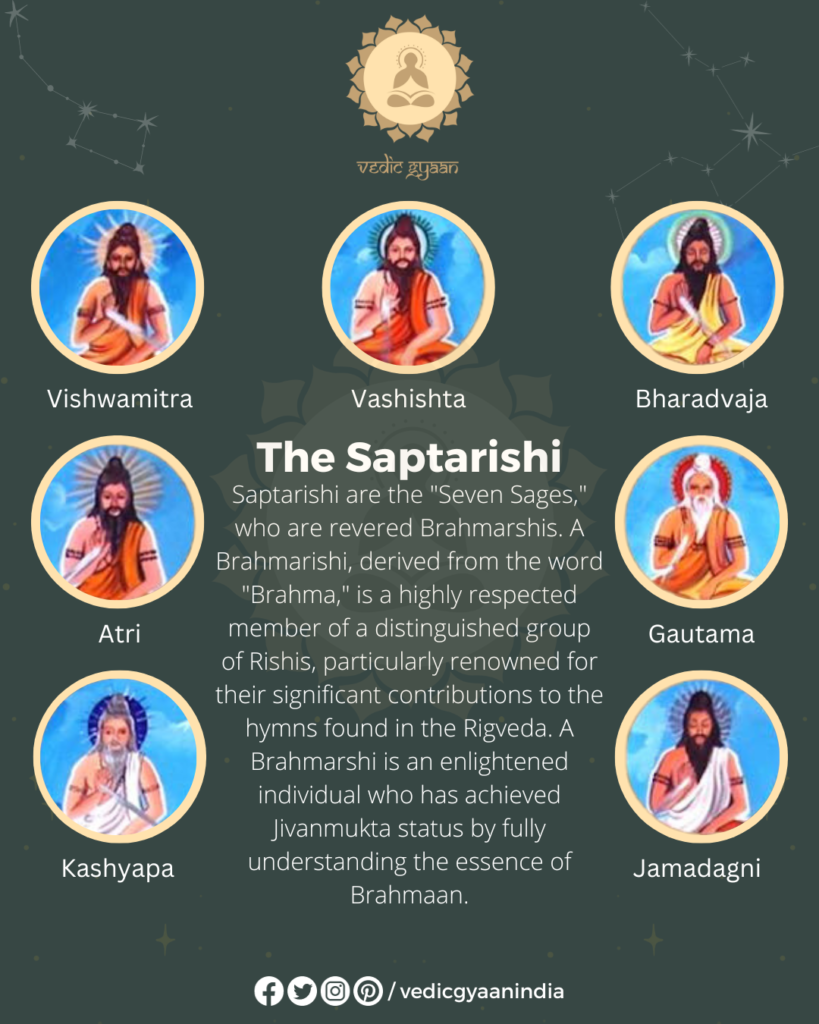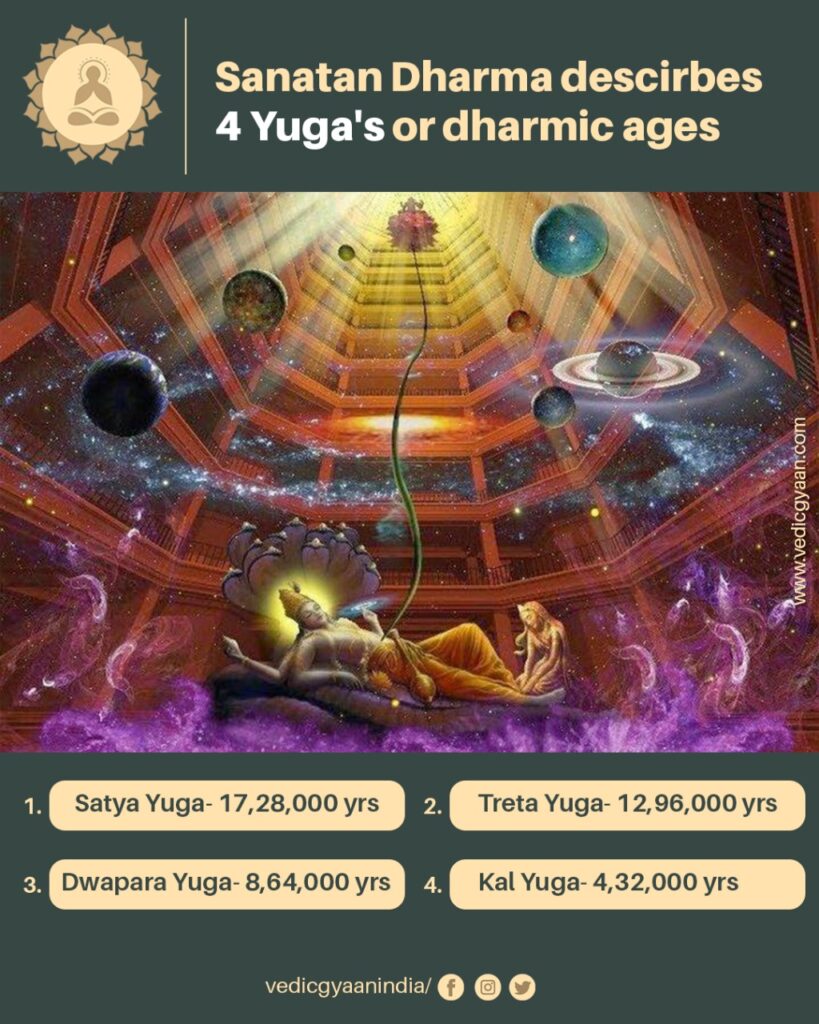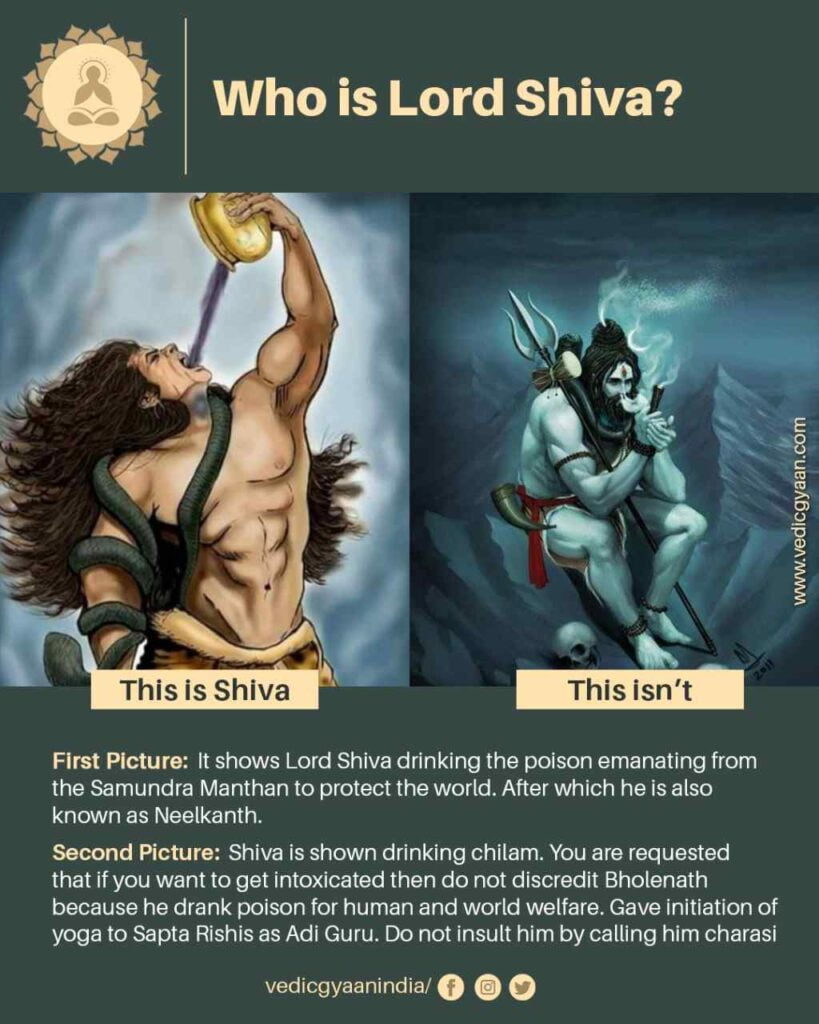Saptarishi signifies the “Seven Sages,” who are essentially revered Brahmarshis. A Brahmarishi, derived from the word “Brahma,” is a highly respected member of a distinguished group of Rishis, particularly renowned for their significant contributions to the hymns found in the Rigveda. A Brahmarshi is an enlightened individual who has achieved Jivanmukta status by fully understanding the essence of Brahman.
These individuals possess supreme divine knowledge, boundless and self-revealing, known as Brahmajnana. It signifies their deep understanding of the importance of Brahman. It’s important to note that one cannot attain the status of a Brahmarishi solely through personal merit, as this order is divinely ordained and appointed by Bhagawan Brahma. Upon passing a Brahmarshi, they achieve Paramukti, liberating themselves from Samsara, the never-ending cycle of birth and death.

Seven Mind-Born Sons of Bhagwan Brahma
The Saptarishi are the seven mind-born sons of Bhagawan Brahma, and they have a specific role during a period known as a manuantara, which spans 306,720,000 Earth Years. Throughout this time, they serve as representatives of Brahma Ji. After each manuantara, when the universe undergoes destruction, the Saptarishis merge with Brahman, and new Saptarishis are appointed to rejuvenate the Earth and spread their divine knowledge.
The initial group of Saptarishis closely collaborated with the Adi Yogi or Shiva to maintain balance on Earth. The identity of the present Saptarishis during the Vyvasvata manuantara may vary in different texts, possibly due to the loss of original texts over time. According to the Mahabharata, Shanti Parva, their identities are mentioned.
मरीचिरत्र्यङ्गिरसौ पुलस्त्यः पुलहः क्रतुः |
वसिष्ठश्च महातेजा एते चित्रशिखण्डिनः।।
“The seven revered Rishis—Marichi, Atri, Angiras, Pulastya, Pulaha, Kratu, and Vasishta—possessing immense energy, collectively referred to as Chitra-sikhandins.”
In the context of the Vaivasuara Manuantara, the Srimad Bhagavatam 8.13.5 lists a different set of seven sages as follows: Kasyapa, Atri, Vasistha, Visvamitra, Gautama, Jamadagni, and Bharadvaja.
Furthermore, in ancient Indian astronomy, the constellation of the Big Dipper is referred to as “Saptarishi,” with its seven stars symbolizing the seven rishis. It’s interesting to note that Ursa Major, Big Bear, and Saptarishi all point to the same constellation in the night sky.
According to ancient scriptures, the Saptarishis possess extraordinary power, allowing them to defeat any earthly weapon, foresee future events, and exist beyond the cycle of birth and death. They are the custodians of divine laws and the guardians of the universe, responsible for maintaining its balance and order.
Knowing the Saptarishis from Shanti Parva
Atri:
Sage Atri is the father of Lord Dattatreya, a prominent deity in Hinduism. The Rigveda’s fifth Mandala (Book 5) is dedicated to him and is known as the Atri Mandala, comprising eighty-seven hymns attributed to Sage Atri and his descendants. His wife, Sati Anusaya, is celebrated as one of the most virtuous and chaste women in Indian history.
Bharadvaja:
Bharadvaja, a revered Vedic sage (maharishi) from ancient India, is acknowledged as the son of Devaguru Brihaspati. He was a distinguished scholar, economist, grammarian, and physician. His notable contributions to ancient Indian literature, particularly the Rig Veda, provide valuable insights into ancient Indian society. Bharadvaja, along with his family of students, is credited as the author of the sixth book of the Rigveda.
In the epic Mahabharata, Bharadwaja is the father of Droṇacharya, who served as the instructor to the princes of the Pandavas and Kauravas. Additionally, Bharadwaja finds mention in the Charaka Samhita, an authoritative ancient Indian medical text.
During their exile, Lord Rama and his companions sought rest in Bharadwaja ashrama while crossing Prayag, and they gratefully accepted his offerings.
Gautama:
Sage Gautama, a revered Maharishi, is recognized as the son of Maharshi Dirghatamas (also known as Rahugana) and Mata Pradveshi. He is renowned as the husband of Ahalya. Sage Gautama relates to the creation of the Godavari, also known as Gautami.
Furthermore, Sage Gautama is known for his authorship of the Gautama Dharmasutra, considering the initial scripture addressing social and religious laws. He also authored the Gautama Medhsutra.
Jamadagni:
Sage Jamadagni, known as the father of Lord Parashurama, an incarnation of Lord Vishnu, hailed from the lineage of Sage Bhrighu, renowned for his audacious act of kicking Lord Vishnu. His ancestor, Sage Jamadagni, was also known for his quick temper.
There is a notable incident involving his wife, Renuka. On one occasion, she was late in fetching water for a ritual. Using his divine powers, Sage Jamadagni perceived that she had been observing Gandharvas and Apsaras enjoying themselves in the water, which led to thoughts of a more luxurious life. Consequently, he instructed his son to take her life. However, he later revived her and brought her back to life at his son’s request.
Sage Jamadagni possessed a divine cow named Kamadhenu at his hermitage. King Sahastrarjuna coveted this cow and attempted to take it by force, but Sage Jamadagni resisted him. Tragically, while the sage was in meditation, King Sahastrarjuna killed him. Upon learning of this heinous act, Lord Parashurama, in his anger and grief, vowed to seek vengeance. Over time, he carried out his vow by eliminating 21 generations of Kshatriyas as retribution for his father’s unjust death.
Kashyapa:
Sage Kashyapa is the father of gods and Asuras (divine beings and demons). He composed certain hymns in the Rigveda in Mandala IX. Kashyapa and his lineage of students are primarily known for hymn composition related to the Soma Pavamāna, a significant moment in the Soma sacrifice.
Regarding the etymology of the name “Kashmir,” there are several theories. Some scholars suggest a shortened form of “Kashyapa Mira,” signifying the “lake of the sage Kashyapa.” Alternatively, it might come from a Kashmiri or Sanskrit meaning “to dry up water.” Another possibility is that it originated from “Kashyapa Meru,” denoting the sacred mountains associated with Kashyapa.
Vashishtha:
Sage Vashishtha is renowned as the guru of Lord Rama and is considered one of the mind-born sons of Lord Brahma. He is the principal author of Mandala 7 of the Rigveda. Sage Vashishtha’s contributions extend to works such as the Yoga Vasishtha, Vasishtha Samhita, and versions of the Agni Purana and Vishnu Purana.
He is also known as the husband of Arundhati and is often referred to as Arundhati Natha in this context. Sage Vashishtha’s life is known for his longstanding feud with Sage Vishwamitra, leading to significant challenges and hardships for him.
Vishwamitra:
Sage Vishwamitra, originally born as a Kshatriya, later evolved into a Brahmin and became one of the greatest sages in ancient India. His spiritual power was so profound that he almost created Pratisrushti, a replica of the world. He is renowned for writing the Gayatri Mantra, one of the most popular and revered Hindu mantras.
Sage Vishwamitra composed a significant portion of Mandala 3 of the Rigveda. However, he had a longstanding conflict with Sage Vashishtha for reasons not mentioned here.
His birth name was Kaushika, but he adopted Vishwamitra later in life. He is well-known for testing the honesty and integrity of King Harishachandra by subjecting him to severe mental and physical hardships.
Due to Sage Vishwamitra’s intense penance and growing power, Indra, the king of gods, became apprehensive and decided to disrupt his meditation. Indra sent an Apsara named Menaka to distract Vishwamitra. Menaka succeeded in her mission, and from their union, Shakuntala was born. Shakuntala later became the mother of King Bharata, from whose name the country India derives its name, Bharata.



